A simple SEO plugin “SEO SIMPLE PACK” was created and released. In this post, we would like to show you how to use it.
We recommend this plugin to those who think “I use a plugin like ‘All in one seo pack’ but it has too many configuration items and is difficult to use.
From Ver. 1.1, more detailed settings for robots tag can be specified for individual pages, which will invalidate the settings for Ver. 1.0. We apologize for the inconvenience to those who have been using Ver. 1.0 or later, but we would appreciate your re-configuration.
How to install
Search for “SEO SIMPLE PACK” on the Add Plugins screen and install it.

You can of course download it from the plugin page of the WordPress directory and upload it manually.
About default settings
This section describes the default settings when the “SEO SIMPLE PACK” is activated.
In addition, the contents shown in the following explanation as “text with background” are those registered as “snippet tags” as described below.
title tag
- Home
-
Site title | Site catchphrase
- Post, Page, Custom post, and media
-
Page title | Site title
- Category, tag, taxonomy, post format archive
-
Category name | Site title
Tag name | Site title
Term name | Site title
Post format name | Site title - Author archive
-
Author name (Nickname) | Site title
- Date archive
-
Date (Y M, D) | Site title
- Post type archive
-
Post type name | Site title
- Search result page
-
Searched: Search word | Site title
- 404 page
-
Page not found | Site title
description tag
- Home
-
No setting (If nothing is set, “catchphrase” will be output)
- Post, Page, Custom post, and media
-
Automatic output from the content of the page (the part within 300 characters after removing unnecessary tags)
- Category, tag, taxonomy, post format archive
-
“This is the archive page for category Category name.”“This is the archive page for tag Tag name.”“This is the archive page for taxonomy name Term name.”From ver. 1.2.1, the default for new installations is “Term Description”.“This is the archive page for post format Post format name.” - Author archive
-
“This is the archive page for Author name (Nickname).”
- Date archive
-
“This is the archive page for Date (Y M, D).”
- Post type archive
-
“This is the archive page for Post type name.”
- Search result page
-
None
- 404 page
-
None
meta keyword tag
Keyword tags are now considered meaningless from an SEO perspective, but they can still be set.
However, the keyword tag does not output anything by default.
meta robots tag
If you select “Do not index XXXX” on the admin page, you can make the page noindex.
The following pages are set as noindex by default.
- Archived Pages
- Media page
- Search results page
- 404 page
The actual output meta tag is "noindex,follow".
Currently, nofollow, noarchive, and other detailed settings are not available. (This will be made selectable in a future update.)
The reason why “follow” is used instead of “nofollow” is because it is better in most cases. For more information, please check with Google or other search engines.
canonical URL
This is automatically output according to the page.
OGP tag
- og:image
-
Posts, pages, and custom posts will use “featured image” if available.
If there is no featured image or other pages, the “Basic Settings” image, which can be set in the “OGP Settings” page in the admin menu, will be used.
No OGP image is specified for basic settings, so nothing will be output by default. - og:locale
-
This is automatically output from WordPress language settings (
wp_locale()). - og:type
-
"article"is output for posts, pages, and custom posts."website"is output for other pages. - og:title
-
The same content as the title tag
- og:description
-
The same content as the description tag
- og:url
-
The contents of
home_url() - og:site_name
-
The “Site Title” set in WordPress
- Facebook setting
-
The settings related to
article:publisher,fb:app_id, andfb:adminstags can be configured.
Nothing is output by default. - Twitter setting
-
The settings related to
twitter:site, andtwitter:cardtags can be configured.
The default card type is “summary“.
Non-used pages
For pages that are rarely used or should not be used for security reasons, access can be denied through redirection.
The following three pages are disabled and redirected to secure pages by default.
- Author archive (Redirect to Home)
- Post format archive (Redirect to Home)
- Media page (Redirect to the image URL)
Also, from ver. 2.4.0, feed pages are no longer indexed.
How to setup
After activating the “SEO SIMPLE PACK,” an item titled “SEO PACK” will be added to the left menu of the admin page.
There are three menus “General Settings”, “OGP Settings” and “HELP,” but only two pages “General Settings” and “OGP Settings” are used for settings.
General settings
“General Settings” menu has tabs for each setting type.
“Basic setting” tab
The following five points can be set:
- Check “Site Title” and “Tagline” which are set in “Settings”->”General” of WordPress.
- Select “delimiter”
-
title,description, andkeywordtag settings for “front page” - Keyword setting for each post when keyword setting is empty
titletag setting for “404 pages” and “search result page”
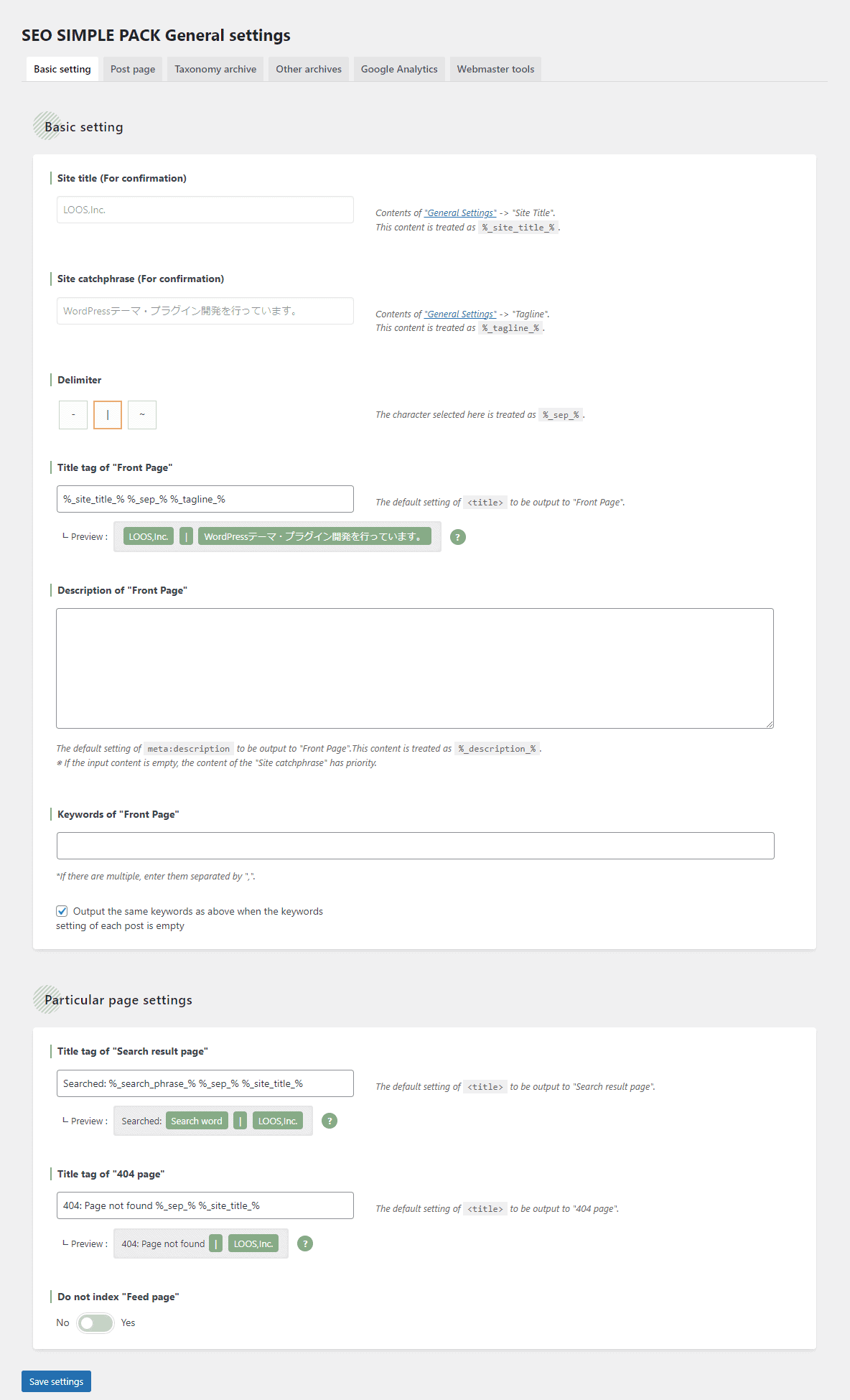
“Post page” tab
The following points can be set:
- Posts
- Pages
- Custom posts (only if registered)
- Media page
Screenshot of the “Post page” setting screen
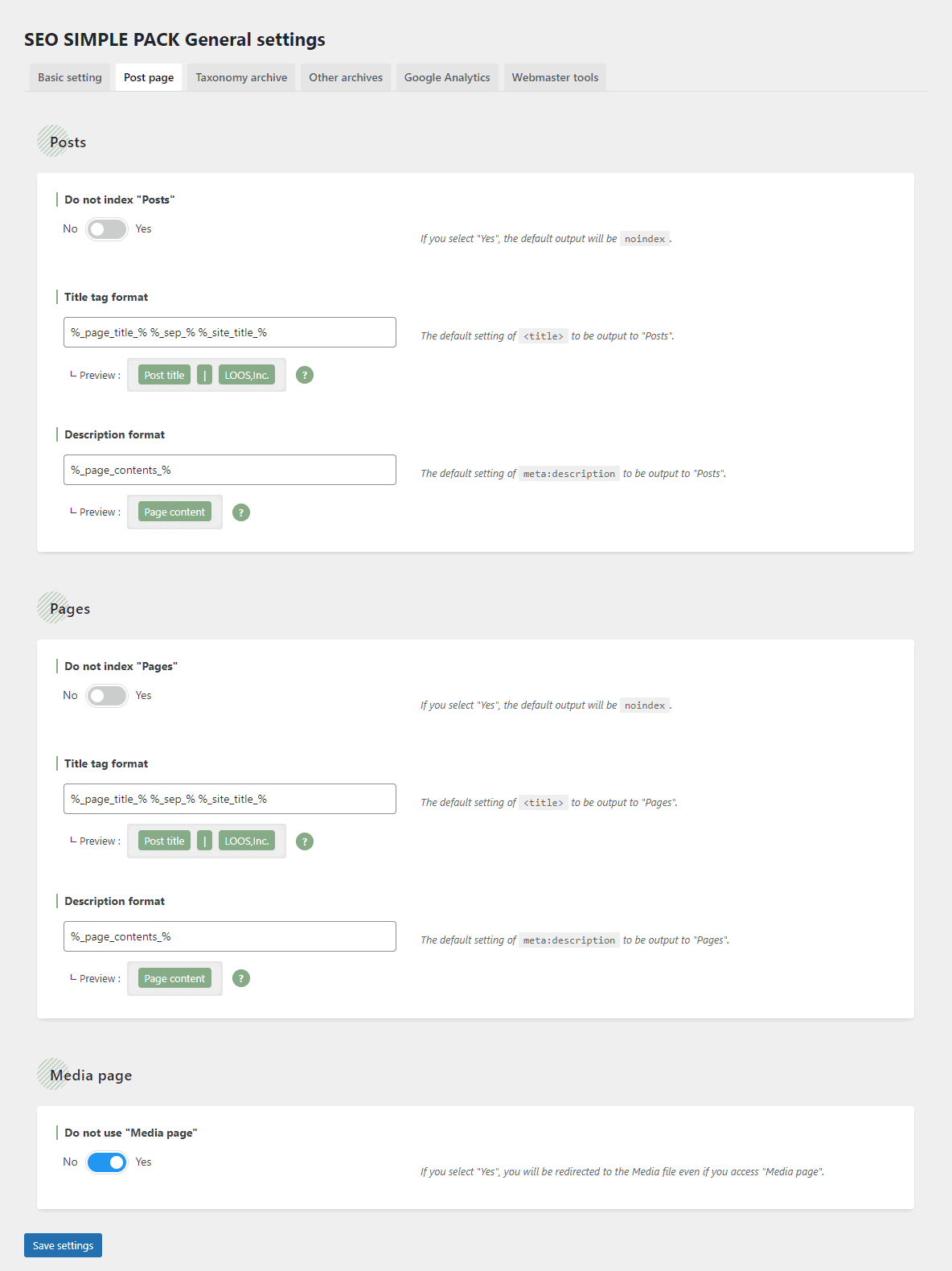
“Taxonomy archive” tab
- Category archive page
- Tag archive page
- Custom Taxonomy archive page (only if registered)
- Post format archive page (from ver. 3.0.0, this will only appear if post format support is enabled)
Screenshot of the “Taxonomy archive” setting screen
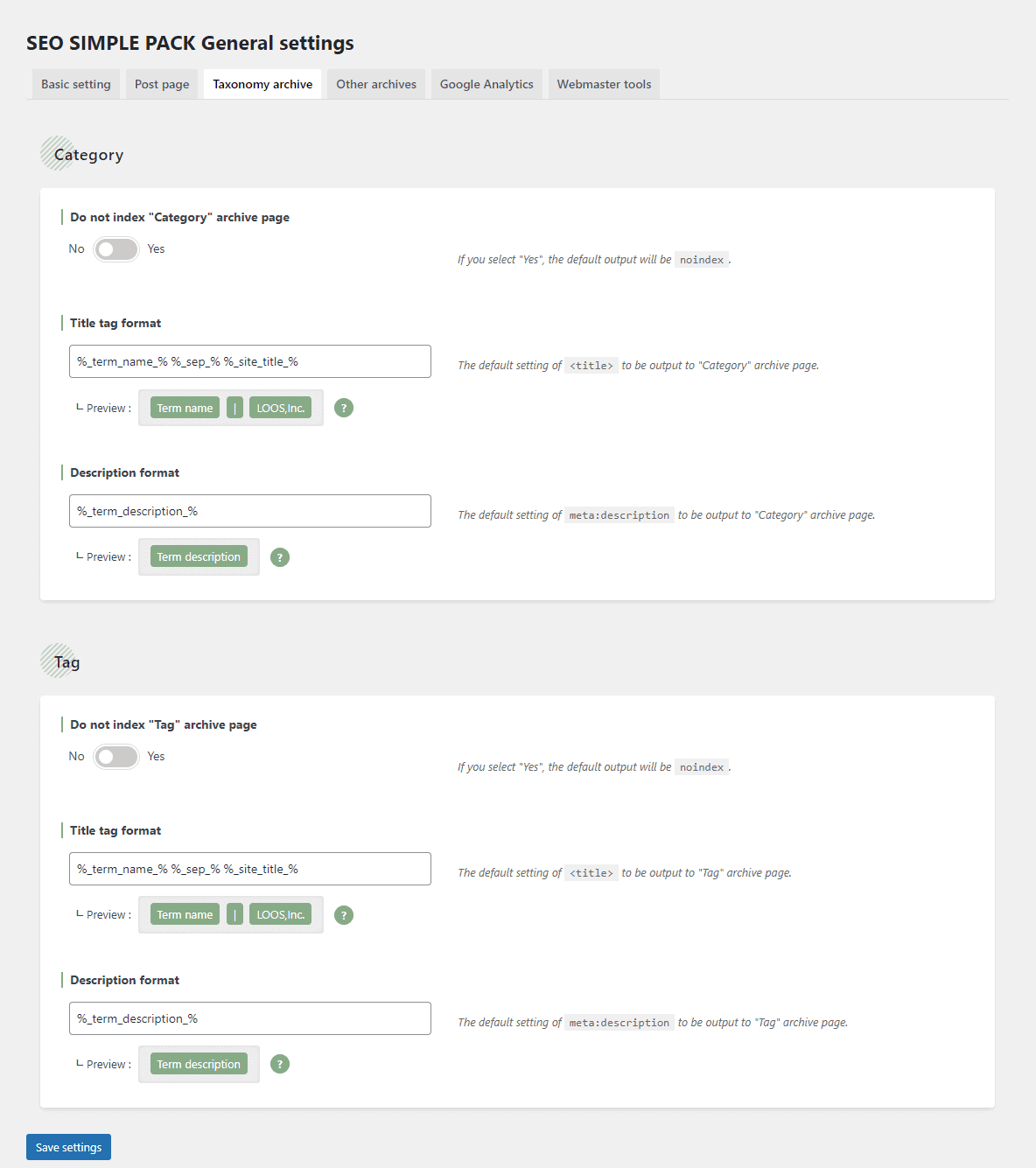
“Other archives” tab
The following points can be set:
- Author archive page
- Date archive page
- Custom post type archive page
Screenshot of the “Other archives” setting screen
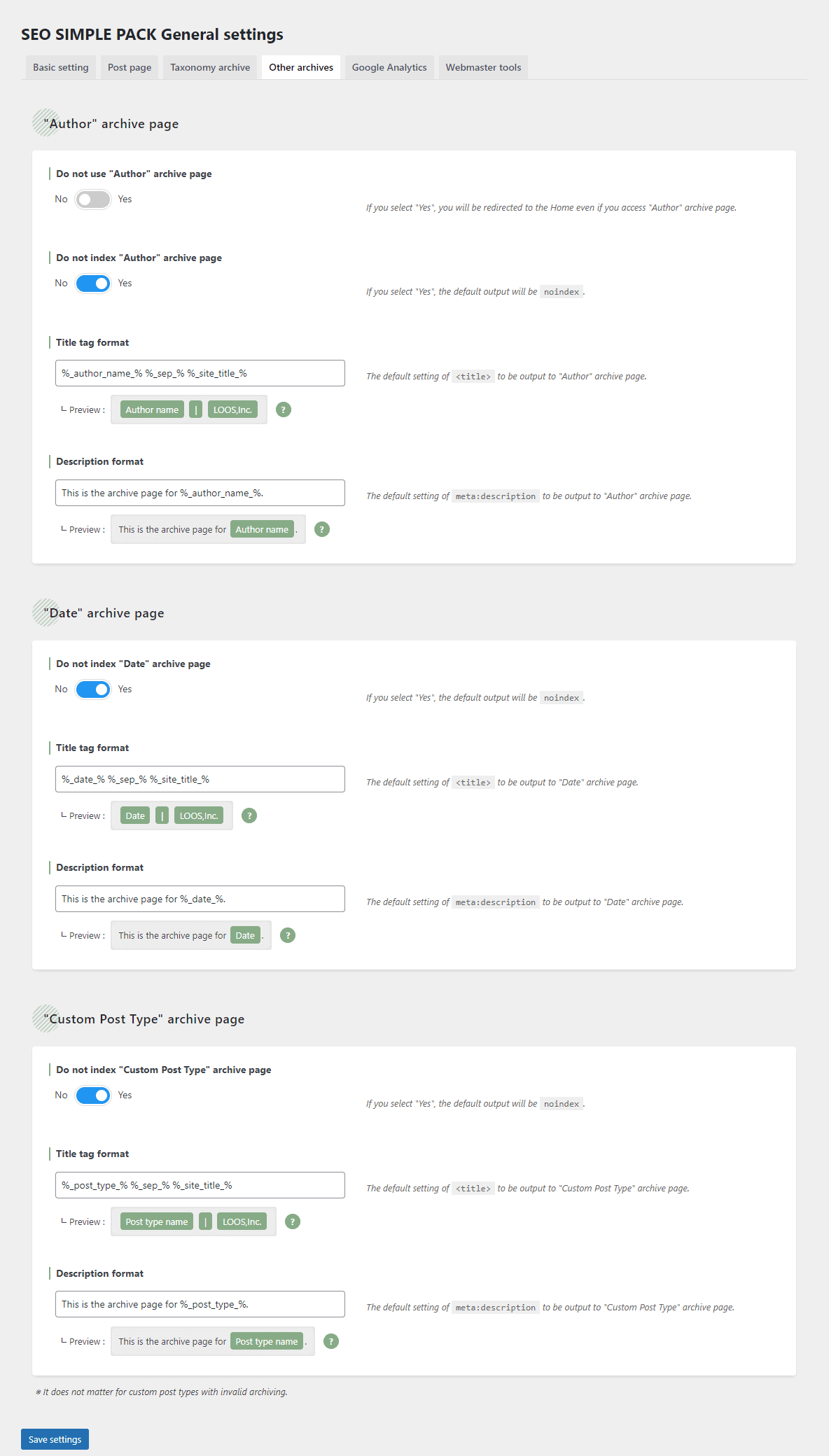
Google Analytics and Webmaster tools
The “General Settings” screen also allows for settings related to “Google Analytics” code and various “Webmaster tools“.
Google Analytics
Simply enter your Google Analytics tracking ID to automatically insert the tracking code.
We recommend using gtag.js if there is no particular reason, but you can also use the previous analytics.js tracking code.
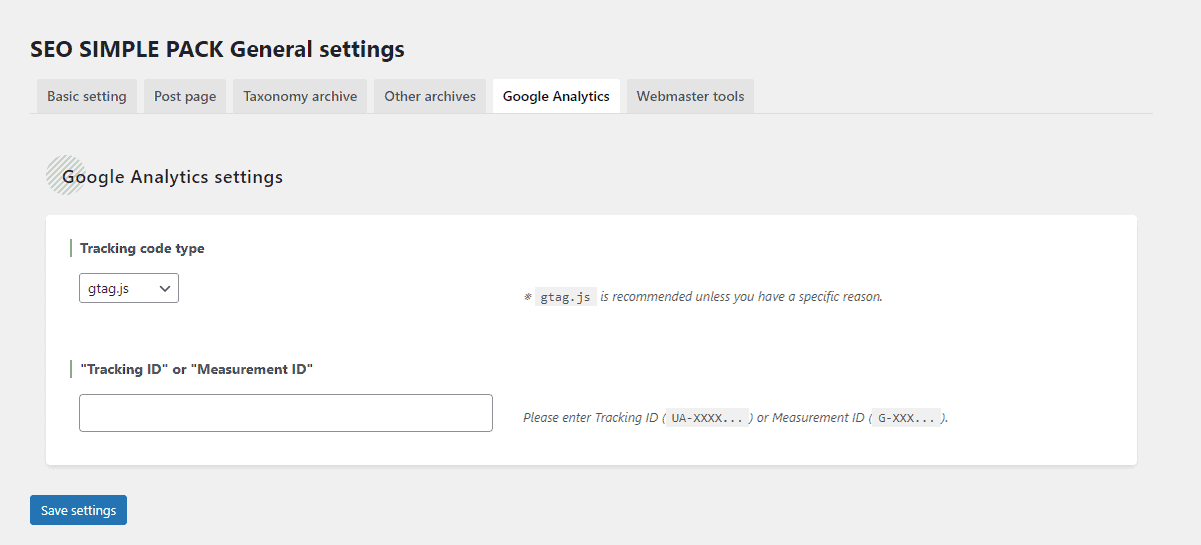
Webmaster tools
Enter each webmaster tools ID to insert authentication code into the home.
The following four webmaster tools are currently supported.
- Google Search Console
- Bing
- Baidu
- Yandex
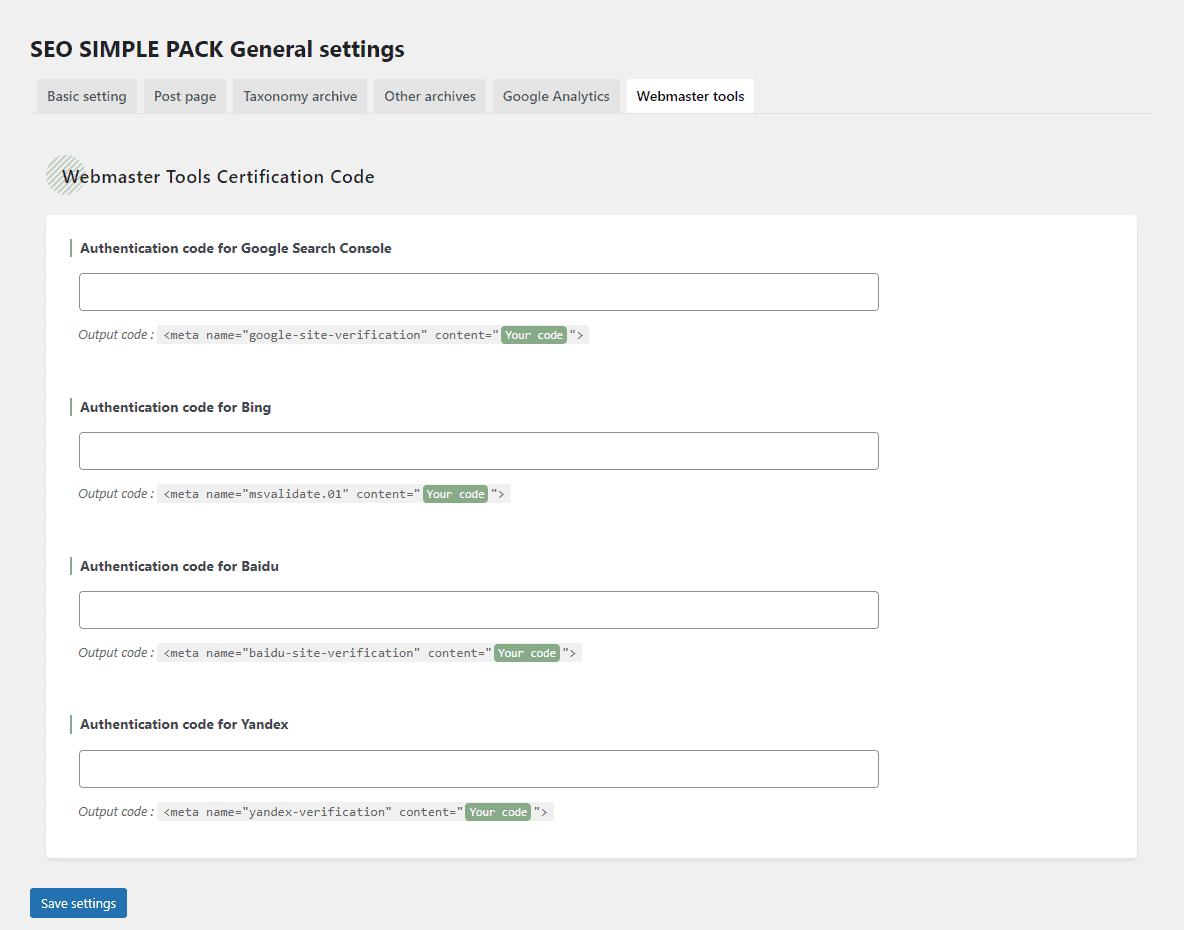
OGP settings
The “OGP Settings” menu allows you to configure various settings related to OGP.
The “Basic Settings” tab is for basic OGP tag settings. (Currently there are only settings for OGP images, but we plan to add more in the future.)
Other settings related to Facebook and Twitter tags are also available.
OGP image
Select the OGP image you want to use in the home.
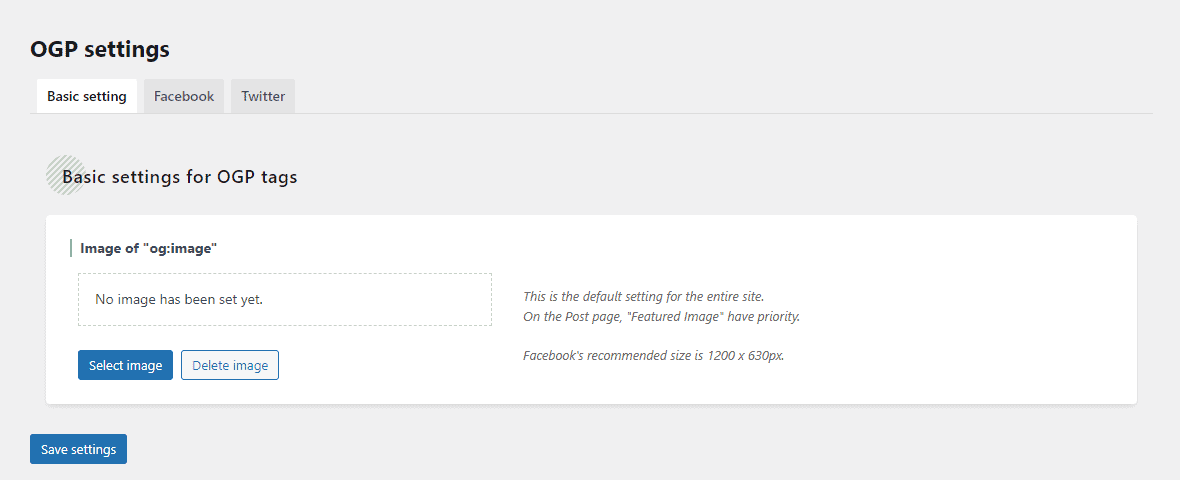
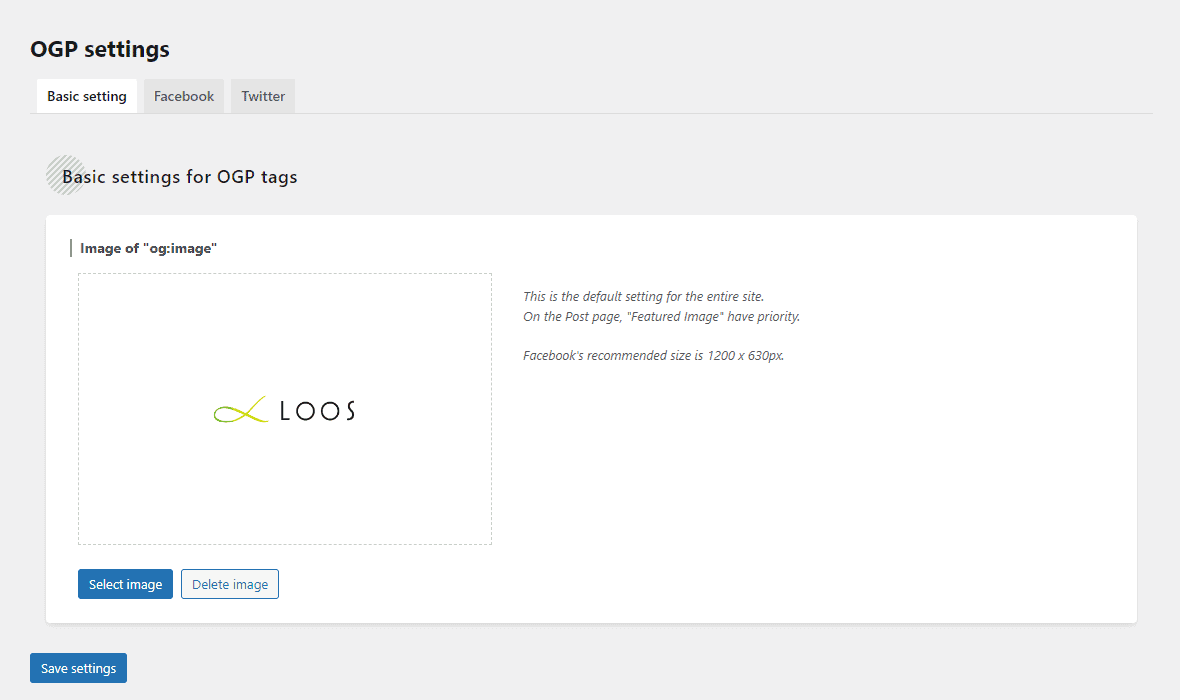
Individually configurable settings
Settings for post, page, and custom post
The meta box (custom field) is displayed on the edit page for posts, pages, and custom posts. This allows you to set individual settings for each article.
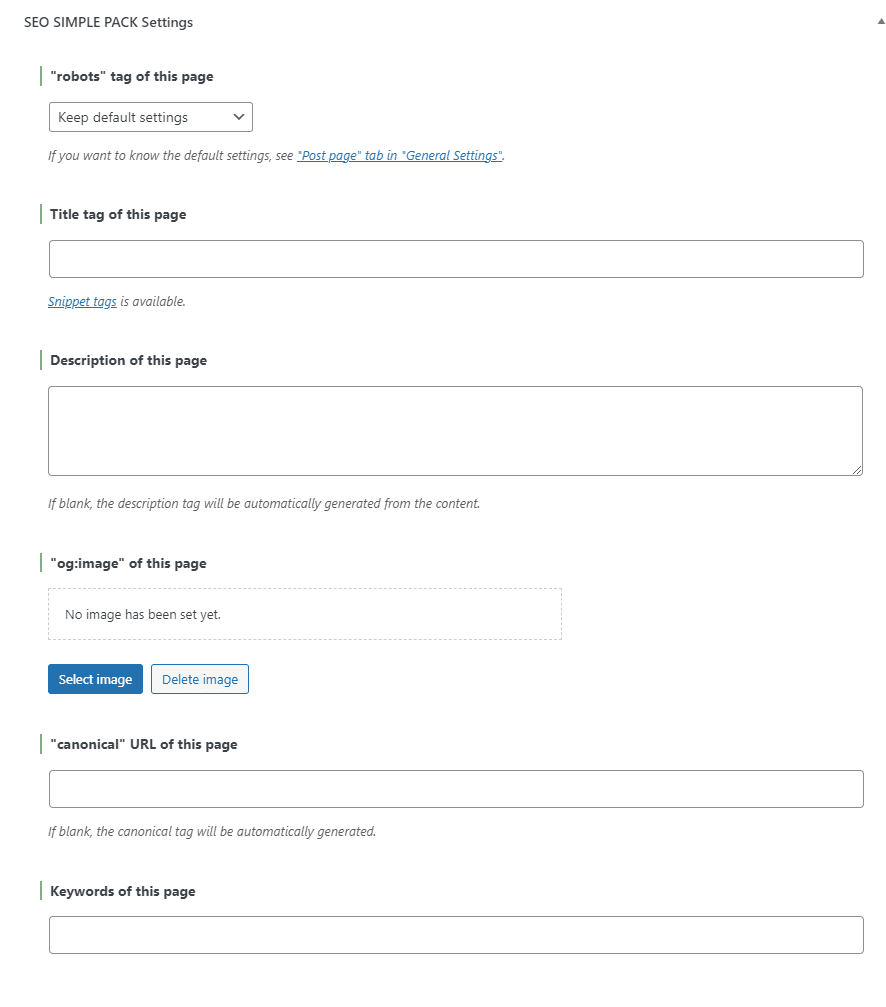
Currently, the following settings are available individually (if nothing is entered, the settings in the settings page will be applied):
noindex setting (Whether to reverse for general settings)- robots setting (You can now specify robots in more detail.)
- title tag setting (ver 1.1 ~)
- description tag setting
- og:image setting (ver 2.0.0 ~)
- canonical URL setting (ver 2.2.0 ~)
- keyword setting
As for the OGP image, if the post has “featured image”, it will take precedence over the OGP image.
Category, tag, and taxonomy settings by term
From ver 1.2.1, individual settings are available for each term archive in addition to the post page.
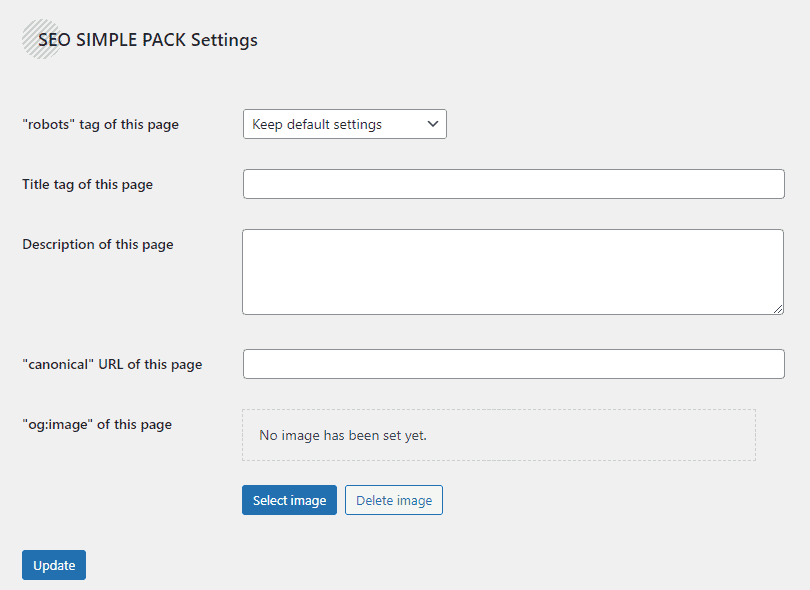
The following settings are now available on each term edit page including categories and tags.
- robots setting
- title tag setting
- description tag setting
- canonical URL setting (ver 2.2.0 ~)
- og:imageのsetting (ver 2.0.0 ~)
About snippet tags
In “SEO SIMPLE PACK,” dynamic contents such as “site title” and “delimiters” can be handled as “snippet tags“.
The following is a list of snippet tags that are currently available.
From ver 3.0.0, some snippet tag names have changed, but previous snippet names will still work.
| Snipet Tag | Snippet tag (old) | Contents to be replaced |
|---|---|---|
%_site_title_% | Site title | |
%_tagline_% | %_phrase_% | Site catchphrase |
%_front_description_% | %_description_% | Front description |
%_sep_% | Delimiter | |
%_page_title_% | Post title | |
%_page_contents_% | Page content | |
%_term_name_% | %_cat_name_%%_tag_name_%%_format_name_% | Term name |
%_term_description_% | Term description | |
%_tax_name_% | Taxonomy name | |
%_post_type_% | Post type name | |
%_date_% | The date that is searching in the date archive | |
%_author_name_% | Author name | |
%_search_phrase_% | Search word |
Use these snippet tags for the text input area in the settings screen.
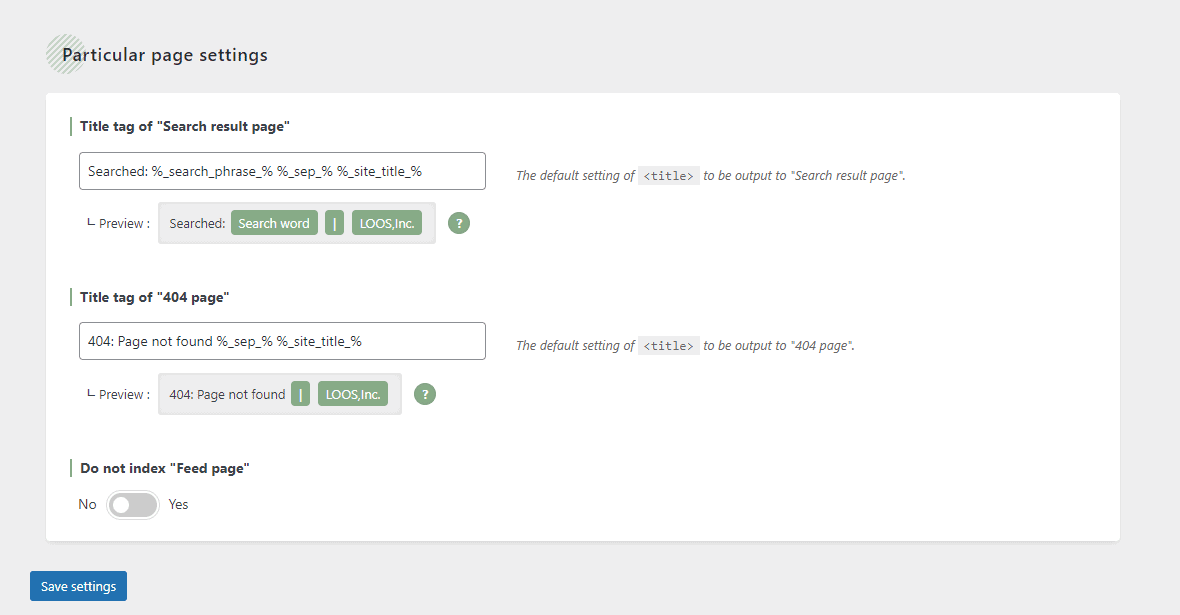
You can see how the snippet tags in the current setting will be replaced in the “Preview” field.
About filter hooks
From ver. 1.1.0, the code has been updated a little more significantly, and apply_filters() has been added before the output of major tags.
This allows you to override the output with whatever you like by add_filter() in your theme’s functins.php.
ssp_output_title: Override the output content of the title tag
function overwrite_ssp_title($ssp_title) {
if ( is_page('book') ) {
// If you want to rewrite only certain pages with special settings
return "Your title";
}
// Other pages are output as is
return $ssp_title;
}
add_filter('ssp_output_title', 'overwrite_ssp_title');ssp_output_robots: Override the output content of the robots tag
function overwrite_ssp_robots($ssp_robots) {
if ( is_page('book') ) {
return "Your robots";
}
return $ssp_robots;
}
add_filter('ssp_output_robots', 'overwrite_ssp_robots');ssp_output_description: Override the output content of the description tag
function overwrite_ssp_description($ssp_description) {
if ( is_page('book') ) {
return "Your description";
}
return $ssp_description;
}
add_filter('ssp_output_description', 'overwrite_ssp_description');ssp_output_keyword: Override the output content of the keyword tag
function overwrite_ssp_keyword($ssp_keyword) {
if ( is_page('book') ) {
return "Your keyword";
}
return $ssp_keyword;
}
add_filter('ssp_output_keyword', 'overwrite_ssp_keyword');ssp_output_canonical: Override the output content of the canonical tag
function overwrite_ssp_canonical($ssp_canonical) {
if ( is_page('book') ) {
return "https://your-canonical.com";
}
return $ssp_canonical;
}
add_filter('ssp_output_canonical', 'overwrite_ssp_canonical');ssp_description_word_count: Change the number of characters in the description
function overwrite_ssp_description_word_count($length) {
if ( is_page('book') ) {
return 30;
}
return $ssp_canonical;
}
add_filter('ssp_description_word_count', 'overwrite_ssp_description_word_count');List of other available filter hook names
| Filter Target | Filter Hook Name |
|---|---|
| og:title | ssp_output_og_title |
| og:description | ssp_output_og_description |
| og:url | ssp_output_og_url |
| og:locale | ssp_output_og_locale |
| og:type | ssp_output_og_type |
| og:site_name | ssp_output_og_site_name(Ver. 2.0.0 以降) |
| og:image | ssp_output_og_image (Ver. 2.0.0 以降) |
| twitter:site | ssp_output_tw_site |
| twitter:card | ssp_output_tw_card |
| fb:app_id | ssp_output_fb_appid |
| fb:admins | ssp_output_fb_admins |
| article:publisher | ssp_output_fb_publisher |
About Filter Hooks for Custom Snippets
In ver. 3.0.0, ssp_replace_snippet_{snippet_name} hook was added. This allows you to replace your own defined custom snippets using the filter hook.
Replace the special snippet “%_custom_%“
function overwrite_ssp_replace_snippet_custom($replace, $context) {
if ( $context === 'title' ) {
return 'カスタム';
}
return $replace;
}
add_filter('ssp_replace_snippet_custom', 'overwrite_ssp_replace_snippet_custom', 10, 2);Conclusion: Update Log
This is the first time we have published our own plugin.
We have implemented only the minimum functions that we need, so there may be some points that are still difficult to use.
We plan to improve the flexibility of the settings in the future, but if you have any requests, please let us know in the comments section of this article.
Postscript (10/22/2018)
Although we struggled with the unfamiliar updating process, we think it is a little better than in the early days.
The SNS settings are still not very flexible, but we have enabled add_filter, so if you are familiar with WordPress, you can set it as you like.
